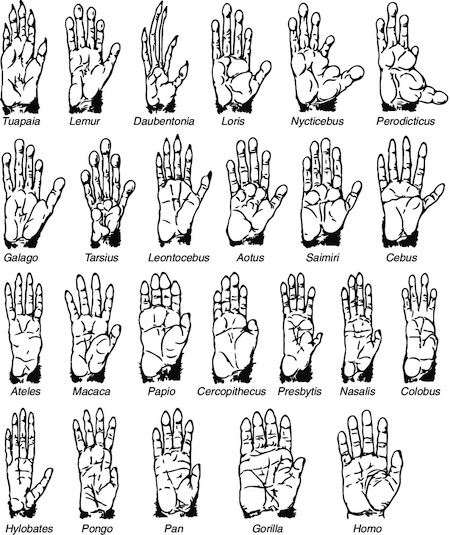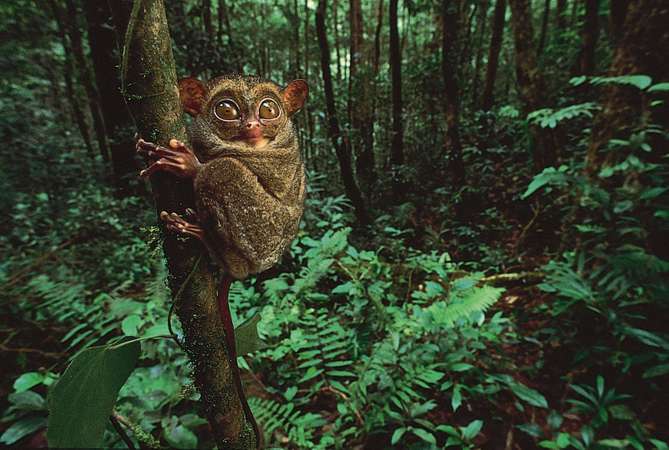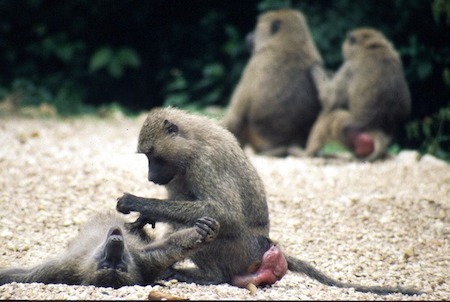 8Primates
8Primates
The first primates appeared Around 47 million years ago. They are descended from a small mammal that lived in trees. One of the traits that sets primates apart from other mammals is the unique anatomy of our hands.
Primates also developed forward-facing eyes that helped them judge distances better, essential for safely jumping from branch to branch.
As for the number of primate species living today, scientists disagree on which species are separate and distinct and which should be considered to be varieties of species. As a result, estimates range from 190 to 350 different species of primates. The consensus, however, ranges from 230 to 270.
Evolution: From Early Mammals to Primates

Primates are a type of mammal that have specialized hands. Scientists think that the early mammals were small creatures that lived in burrows. Over time some of these rodent like mammals started to climb trees and live in the tree canopy. The advantage of living up in the trees included easier access to fruit, and protection from land based predators.
The evolution of hands gave primates a big survival advantage. Grasping hands made it possible for primates to swing between tree branches, pick fruit and throw rocks. Hands also change the family structure. They allow the mother and the baby to hang onto each other and travel together.
Primates: Talented Hands
Hands (including humans’ opposable thumbs) mark a giant step in the evolution of mammals.
The blueprint for hands and fingers is contained in the ancient claws of the first reptiles. Scientists compare skeletons from different animals to study the evolution of limbs.
(illustration comparing reptile claws, rodents claws to hands).
Hands enable us to pick up our babies, make and use tools, wield weapons to defend ourselves and to bring down prey. With hands we make fire, perform brain surgery, create art, play musical instruments, participate in sports like baseball and so much more.
Primates: Vision

Forward-facing eyes are another feature of primates. Stereoscopic vision gives us the ability to recognize how far away the next branch might be, so a leap is successful and not fatal.
Hand-eye coordination is an important part of the formula that makes primates unique. Our excellent vision evolved alongside our agility. With hands and eyes working together, primates can leap from branch to branch and pluck fruit.
Primates: Social Bonds
Finally, people and other primates like apes and monkeys hold hands with one another. This display of affection serves to strengthen the bonds among the group.
As the science writer Carl Zimmer put it, “The hand is where the mind meets the world.”

Primates: Diversity of Species
Today, primates include a wide variety of monkeys, lesser apes like lemurs and Great Apes like us. (To the question, “When did humans split from apes?” the scientific answer is, it hasn’t happened yet. Humans are part of the ape family.)
Primates: Habitats
When primates first evolved, the climate on Earth was warm and tropical.
Most of the continents were covered in forest, a great environment for the evolution of flowers and fruits. If you were a tree-dwelling primate, life was sweet!
For millions of years Primates thrived in different forest habitats. A few million years ago dramatic climate change occurred in the region of the African continent where humans first evolved. As the climate grew hotter and drier, many of the forests disappeared and were replaced by open grasslands. That is when a branch of the primate family started to walk upright, and in a new direction.
What do You have in Common with Early Primates?
Like the early Primates you have excellent hand eye coordination. You are attracted to bright, round objects that look like ripe fruit and have an active appetite for sweet tasting foods.
WHAT’S NEXT?
A branch of the primate family split off and evolved into a hominid.
Learn More
Neil deGrasse Tyson First Primates 13:00
https://www.youtube.com/watch?v=W_X5ciqtbG0
At 6:00 intermediate species called Plesiadapiform 120 species
At 10:35 Dryomomys transitional species
At 11:30 co-evolution with fruits
What makes a primate a primate? Very good chart
http://tolweb.org/treehouses/?treehouse_id=3029
Major traits of primates
https://animals.mom.me/major-characteristics-primates-3721.html
Jane spells it out. Also a very good primate org chart
http://news.janegoodall.org/2018/06/27/chimps-humans-monkeys-whats-difference/
Primates vs. other mammals, good summation
https://www.reference.com/pets-animals/primates-different-other-mammals-3b1658e558e1cce6
DOCUMENTARIES ON PRIMATES
Attenborough Clever Monkeys (49:00)
https://www.youtube.com/watch?v=NXldsdI1DTc
Bonobos (47:00)
https://www.youtube.com/watch?v=o2OOB-dH1s4
Frans de Waal TED talk morality in animals (17:00)
https://www.youtube.com/watch?v=GcJxRqTs5nk
